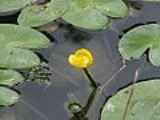
Nuphar lutea
Encyclopedia
Nuphar lutea is an aquatic plant
of the family Nymphaeaceae
, native to temperate regions of Europe
, northwest Africa
, and western Asia
.
is solitary, terminal, held above the water surface; it is hermaphrodite
, 2–4 cm diameter, with five or six large bright yellow sepal
s and numerous small yellow petal
s largely concealed by the sepals. Flowering is from June to September, and pollination is entomophilous
, by flies attracted to the alcohol
ic scent. The flower is followed by a green bottle-shaped fruit, containing numerous seeds which are dispersed by water currents. The species is less tolerant of water pollution than water-lilies in the genus Nymphaea
.
and giving the species a holarctic
range, but the genus is now more usually divided into eight species (see Nuphar
for details).
Aquatic plant
Aquatic plants are plants that have adapted to living in aquatic environments. They are also referred to as hydrophytes or aquatic macrophytes. These plants require special adaptations for living submerged in water, or at the water's surface. Aquatic plants can only grow in water or in soil that is...
of the family Nymphaeaceae
Nymphaeaceae
Nymphaeaceae is a family of flowering plants. Members of this family are commonly called water lilies and live in freshwater areas in temperate and tropical climates around the world. The family contains eight genera. There are about 70 species of water lilies around the world. The genus...
, native to temperate regions of Europe
Europe
Europe is, by convention, one of the world's seven continents. Comprising the westernmost peninsula of Eurasia, Europe is generally 'divided' from Asia to its east by the watershed divides of the Ural and Caucasus Mountains, the Ural River, the Caspian and Black Seas, and the waterways connecting...
, northwest Africa
Africa
Africa is the world's second largest and second most populous continent, after Asia. At about 30.2 million km² including adjacent islands, it covers 6% of the Earth's total surface area and 20.4% of the total land area...
, and western Asia
Asia
Asia is the world's largest and most populous continent, located primarily in the eastern and northern hemispheres. It covers 8.7% of the Earth's total surface area and with approximately 3.879 billion people, it hosts 60% of the world's current human population...
.
Growth
It grows in eutrophic freshwater beds, with its roots fixed into the lake bed and its leaves floating on the water surface; it can grow in water up to 5 metres deep. The flowerFlower
A flower, sometimes known as a bloom or blossom, is the reproductive structure found in flowering plants . The biological function of a flower is to effect reproduction, usually by providing a mechanism for the union of sperm with eggs...
is solitary, terminal, held above the water surface; it is hermaphrodite
Hermaphrodite
In biology, a hermaphrodite is an organism that has reproductive organs normally associated with both male and female sexes.Many taxonomic groups of animals do not have separate sexes. In these groups, hermaphroditism is a normal condition, enabling a form of sexual reproduction in which both...
, 2–4 cm diameter, with five or six large bright yellow sepal
Sepal
A sepal is a part of the flower of angiosperms . Collectively the sepals form the calyx, which is the outermost whorl of parts that form a flower. Usually green, sepals have the typical function of protecting the petals when the flower is in bud...
s and numerous small yellow petal
Petal
Petals are modified leaves that surround the reproductive parts of flowers. They often are brightly colored or unusually shaped to attract pollinators. Together, all of the petals of a flower are called a corolla. Petals are usually accompanied by another set of special leaves called sepals lying...
s largely concealed by the sepals. Flowering is from June to September, and pollination is entomophilous
Entomophily
Entomophily is a form of pollination whereby pollen is distributed by insects. Several insect are reported to be responsible for the pollination of many plant species, particularly bees, Lepidoptera , wasps, flies, ants and beetles. Some plant species co-evolved with a particular pollinator, such...
, by flies attracted to the alcohol
Ethanol
Ethanol, also called ethyl alcohol, pure alcohol, grain alcohol, or drinking alcohol, is a volatile, flammable, colorless liquid. It is a psychoactive drug and one of the oldest recreational drugs. Best known as the type of alcohol found in alcoholic beverages, it is also used in thermometers, as a...
ic scent. The flower is followed by a green bottle-shaped fruit, containing numerous seeds which are dispersed by water currents. The species is less tolerant of water pollution than water-lilies in the genus Nymphaea
Nymphaea
Nymphaea is a genus of aquatic plants in the family Nymphaeaceae. There are about 50 species in the genus, which has a cosmopolitan distribution.-Name:The common name, shared with some other genera in the same family, is Water Lily....
.
Taxonomy
Some botanists have treated Nuphar lutea as the sole species in Nuphar, including all the other species in it as subspeciesSubspecies
Subspecies in biological classification, is either a taxonomic rank subordinate to species, ora taxonomic unit in that rank . A subspecies cannot be recognized in isolation: a species will either be recognized as having no subspecies at all or two or more, never just one...
and giving the species a holarctic
Holarctic
The Holarctic ecozone refers to the habitats found throughout the northern continents of the world as a whole. This region is divided into the Palearctic, consisting of Northern Africa and all of Eurasia, with the exception of Southeast Asia and the Indian subcontinent, and the Nearctic,...
range, but the genus is now more usually divided into eight species (see Nuphar
Nuphar
Nuphar is genus of aquatic plants in the family Nymphaeaceae, with a temperate to subarctic Northern Hemisphere distribution. Common names include water-lily , pond-lily, and spatterdock .A total of eight species and three hybrids are currently accepted in the genus...
for details).

